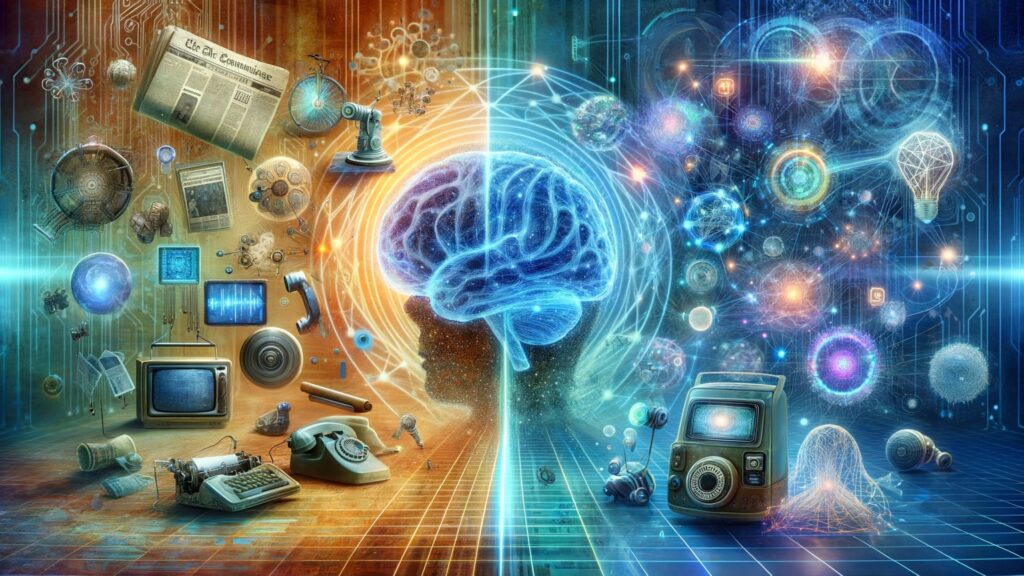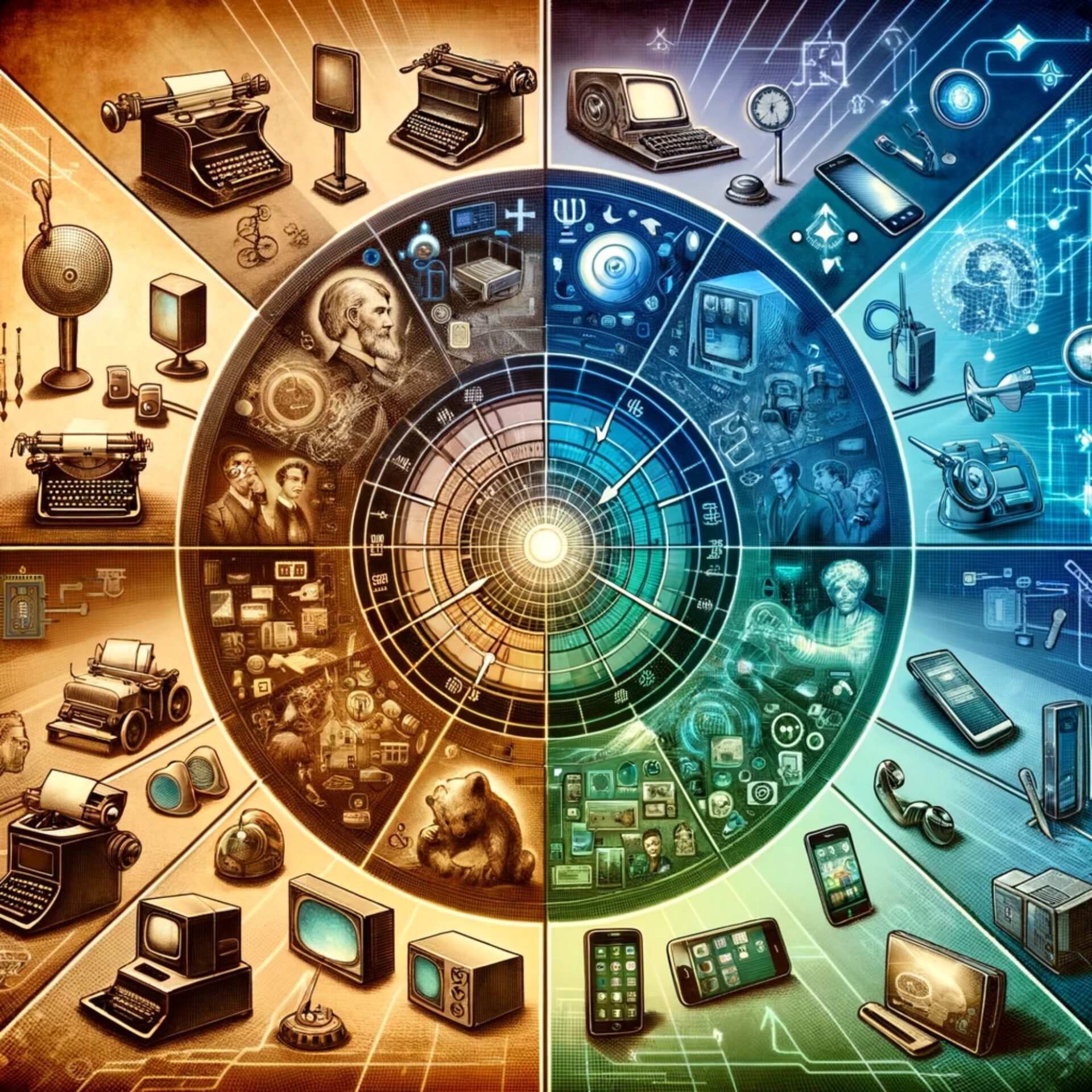The story of digital communication technologies is a tale of continuous development, marked by groundbreaking innovations and rapid transformations that have reshaped the way we connect, interact, and share information. From the early days of telegraph and radio to the advent of the internet and smartphones, each step in this journey has marked a pivotal shift in our communication landscape.
The Roots of Digital Communication
The genesis of digital communication can be traced back to the 19th century with the invention of the telegraph. This device revolutionized long-distance communication by transmitting messages in Morse code across wires. Following this, the late 1800s and early 1900s saw the emergence of radio and telephone, technologies that began to shrink the world by allowing real-time voice communication over long distances.
The Internet Revolution
The true game-changer, however, was the advent of the internet in the late 20th century. Initially a tool for military and academic purposes, the internet quickly permeated into everyday life, fundamentally altering how people communicated. Email became the new norm for written communication, replacing traditional mail for many purposes due to its immediacy and reach.
The Mobile and Social Media Surge
The turn of the millennium witnessed the rise of mobile technologies and social media, marking another seismic shift in digital communication. Smartphones transformed communication from a stationary activity to a ubiquitous part of daily life, enabling people to connect anytime, anywhere. Social media platforms like Facebook, Twitter, and Instagram further revolutionized this landscape, making it easier than ever to share life updates, news, and opinions with a global audience.
Real-Time Communication and Collaboration
Advancements in broadband and mobile internet gave rise to new forms of real-time communication, such as video conferencing and instant messaging. Tools like Skype, WhatsApp, and later Zoom became staples in both personal and professional communication, allowing for seamless video and text communication across continents.
The Rise of Generative AI in Communication

The landscape of digital communication has been dramatically reshaped by the emergence of generative artificial intelligence (AI). This technology, which involves AI algorithms capable of generating text, images, and even code, is revolutionizing the way we interact with digital systems and each other.
Generative AI: A New Era in Digital Interaction
Generative AI refers to a class of AI that can create content. It’s not just about understanding or processing information, but about generating new, original material. This technology came into the spotlight with systems like OpenAI’s GPT (Generative Pre-trained Transformer) models, which can compose text that’s indistinguishable from human writing.
Applications in Communication
- Chatbots & Virtual Assistants: AI-driven chatbots have evolved for customer service.
- Content Creation: Generative AI used for writing, marketing, and coding.
- Personalized Communication: AI tailors content for personalized experiences.
Advancements and Challenges
While generative AI holds great promise, it also presents challenges. Issues around data privacy, the potential for generating misleading information, and the need for oversight in content creation are significant concerns. Ensuring ethical use and preventing misuse of this technology are critical areas for ongoing research and regulation.
Code Example in AI Communication
A simple example of AI-generated communication can be seen in a Python script using an AI model like GPT-3. Here’s a basic example
import openai
openai.api_key = 'your-api-key'
response = openai.Completion.create(
model="text-davinci-003",
prompt="Write a summary about the latest trends in digital communication:",
max_tokens=150
)
print(response.choices[0].text.strip())This script uses the OpenAI API to generate a summary about digital communication trends. The model ‘text-davinci-003’ refers to a specific version of GPT-3.
Impact of Social Media and User-Generated Content (UGC)
The digital communication landscape has been profoundly influenced by the rise of social media and user-generated content (UGC). These platforms have redefined how individuals interact, share information, and even influence societal trends.
Social Media: A Global Conversation Platform
- Social Media: Transformed communication, enables global sharing.
- Real-time Interaction: Facilitates engagement with current events.
- Networking & Community: Builds communities based on interests.
- Influencer Marketing: Empowers individuals with large followings.
User-Generated Content: Democratizing Media Production
UGC refers to any form of content—text, videos, images, reviews, etc.—created by individuals rather than media companies or brands. This democratization of content production has several implications:
- Content Diversity: UGC offers a diverse range of perspectives, often filling gaps left by traditional media.
- Engagement and Virality: Content created by users tends to be more relatable and engaging, leading to higher levels of interaction and the potential for virality.
- Challenges of Moderation: The sheer volume and variety of UGC pose significant challenges in content moderation, especially concerning misinformation and harmful content.
Analyzing Social Media Trends with Data
Data analysis plays a crucial role in understanding and leveraging social media trends. Here’s an example of how Python can be used to analyze Twitter data
import tweepy
# Authentication with Twitter API
auth = tweepy.OAuthHandler('consumer_key', 'consumer_secret')
auth.set_access_token('access_token', 'access_token_secret')
api = tweepy.API(auth)
# Retrieve Tweets containing a specific hashtag
for tweet in tweepy.Cursor(api.search, q='#DigitalCommunication').items(10):
print(tweet.text)This script demonstrates how to authenticate with the Twitter API using Tweepy, a Python library, and retrieve a limited number of tweets containing a specific hashtag.
Advancements in Cloud and Edge Computing
Cloud and edge computing have significantly impacted digital communication, offering new capabilities and efficiencies. These technologies have become fundamental in handling the vast amount of data generated and processed in digital communications.
Cloud Computing: The Backbone of Modern Digital Communication
Cloud computing provides on-demand computing services and storage over the internet. This technology has several key benefits:
- Scalability and Flexibility: It allows businesses and individuals to scale services according to their needs without investing in physical infrastructure.
- Data Management and Analysis: The cloud offers powerful tools for storing, managing, and analyzing data, crucial for businesses leveraging big data in decision-making.
- Supporting Remote Work: Cloud services have been integral in supporting remote and collaborative work environments, enabling access to resources and communication tools from anywhere.
Edge Computing: Bringing Processing Closer to Data Sources
Edge computing refers to computing processes performed closer to data sources (like IoT devices) rather than centralized data-processing warehouses. This approach has several advantages:
- Reduced Latency: By processing data closer to its source, edge computing reduces latency, which is essential for real-time applications.
- Bandwidth Optimization: It minimizes the need to send vast amounts of data over a network, conserving bandwidth.
- Enhanced Security: Local data processing can improve security, as sensitive data doesn’t have to travel over the network.
Cloud and Edge in Digital Communication: A Use Case
A practical use case of cloud and edge computing in digital communication is in IoT devices. For instance, smart home devices like security cameras process data (edge computing) and send relevant information to the cloud for further analysis or storage.
Demonstrating Cloud and Edge Computing with Code
Although simulating cloud and edge computing environments in code goes beyond simple scripts, one can demonstrate the concept of data processing and storage using Python:
# Simulated data processing at the 'edge'
def process_data(data):
processed_data = "Processed " + data
return processed_data
# Simulated data storage in the 'cloud'
def store_in_cloud(data):
print(f"Storing in cloud: {data}")
# Example Usage
raw_data = "Sensor Data"
processed_data = process_data(raw_data)
store_in_cloud(processed_data)This simple example demonstrates data being processed (as it would be at the edge) and then sent to the cloud for storage.
Digital Identity and Trust Architectures

The development of digital identity and trust architectures marks a significant milestone in the development of digital communication technologies. These systems are crucial for ensuring security, privacy, and trust in online interactions.
Understanding Digital Identity
Digital identity refers to the online representation of an individual, organization, or device. It encompasses various credentials and attributes used for identification and authentication in digital spaces.
- Authentication and Verification: Digital identity systems authenticate users through various means, such as passwords, biometrics, or multi-factor authentication, ensuring that individuals are who they claim to be online.
- Privacy and Control: Modern digital identity solutions focus on user privacy, giving individuals control over their personal information and how it’s shared.
Trust Architectures: Ensuring Secure Communication
Trust architectures are frameworks and technologies that ensure the integrity and security of digital communications.
- Encryption: Encryption technologies protect data privacy by encoding messages so that only authorized parties can decipher them.
- Blockchain and Decentralized Systems: Blockchain technology offers a decentralized approach to digital trust, ensuring transparency and tamper-proof records.
Implementing Basic Encryption for Secure Communication
To demonstrate a fundamental aspect of trust architectures, here’s an example of simple encryption and decryption in Python, using the Fernet symmetric encryption:
from cryptography.fernet import Fernet
# Generate a key
key = Fernet.generate_key()
cipher_suite = Fernet(key)
# Encrypting a message
text = "Secure Message"
encrypted_text = cipher_suite.encrypt(text.encode())
print(f"Encrypted: {encrypted_text}")
# Decrypting the message
decrypted_text = cipher_suite.decrypt(encrypted_text).decode()
print(f"Decrypted: {decrypted_text}")This script shows basic encryption and decryption, which is a cornerstone of secure digital communication.
The Role of Automation and Chatbots
Automation and chatbots have become increasingly central in digital communication, streamlining interactions and enhancing user experiences across various platforms.
Communication Automation
Digital communication automation encompasses employing technology to handle and reply to messages without human involvement, spanning from basic auto-reply emails to sophisticated customer service chatbots.
- Efficiency and Consistency: Automated systems can handle repetitive tasks efficiently, ensuring consistent responses to common queries.
- 24/7 Availability: Unlike human operators, automated systems can provide round-the-clock service, crucial for global businesses.
- Personalization: Advanced systems can tailor responses based on user data and past interactions, offering a personalized communication experience.
Chatbots: Revolutionizing Customer Interactions
Chatbots, powered by AI and machine learning, have taken automation a step further. They can engage in more natural conversations with users, offering assistance, answering queries, and even handling complex tasks.
- Customer Service: Many businesses use chatbots for customer service, providing quick responses to customer inquiries and reducing the load on human staff.
- E-commerce and Sales: Chatbots assist in the shopping experience by offering product recommendations, answering questions, and even facilitating transactions.
- Information and Assistance: In domains like healthcare and banking, chatbots provide users with vital information and guidance.
Building a Simple Chatbot in Python
While building a fully functional AI-driven chatbot requires extensive programming and AI training, here’s a basic example of a rule-based chatbot in Python:
def simple_chatbot(input_text):
if "hello" in input_text.lower():
return "Hello there! How can I assist you today?"
elif "help" in input_text.lower():
return "Sure, I'm here to help. What do you need assistance with?"
else:
return "I'm sorry, I didn't understand that. Can you please rephrase?"
# Example interaction with the chatbot
user_input = "Hello, can you help me?"
response = simple_chatbot(user_input)
print(response)This script demonstrates a very basic chatbot that responds to specific keywords in the user input.
Conclusion
The journey of digital communication technologies is a testament to human ingenuity and the relentless pursuit of advancement. From the early days of telegraphs and telephones to the sophisticated landscape of AI, cloud computing, and the emerging metaverse, each step has reshaped our ability to connect and interact. The evolution of these technologies not only reflects our technical progress but also mirrors the changing ways in which we perceive and experience connection in a digital age.
Looking ahead, the future of digital communication is poised at an exciting juncture, brimming with possibilities that were once the realm of science fiction. The integration of advanced AI, quantum computing, and immersive virtual environments promises to further blur the lines between the physical and digital worlds. As we navigate this evolving landscape, the challenges and opportunities presented by these technologies will undoubtedly continue to drive innovation, reshape industries, and redefine our understanding of digital interaction and connectivity.




